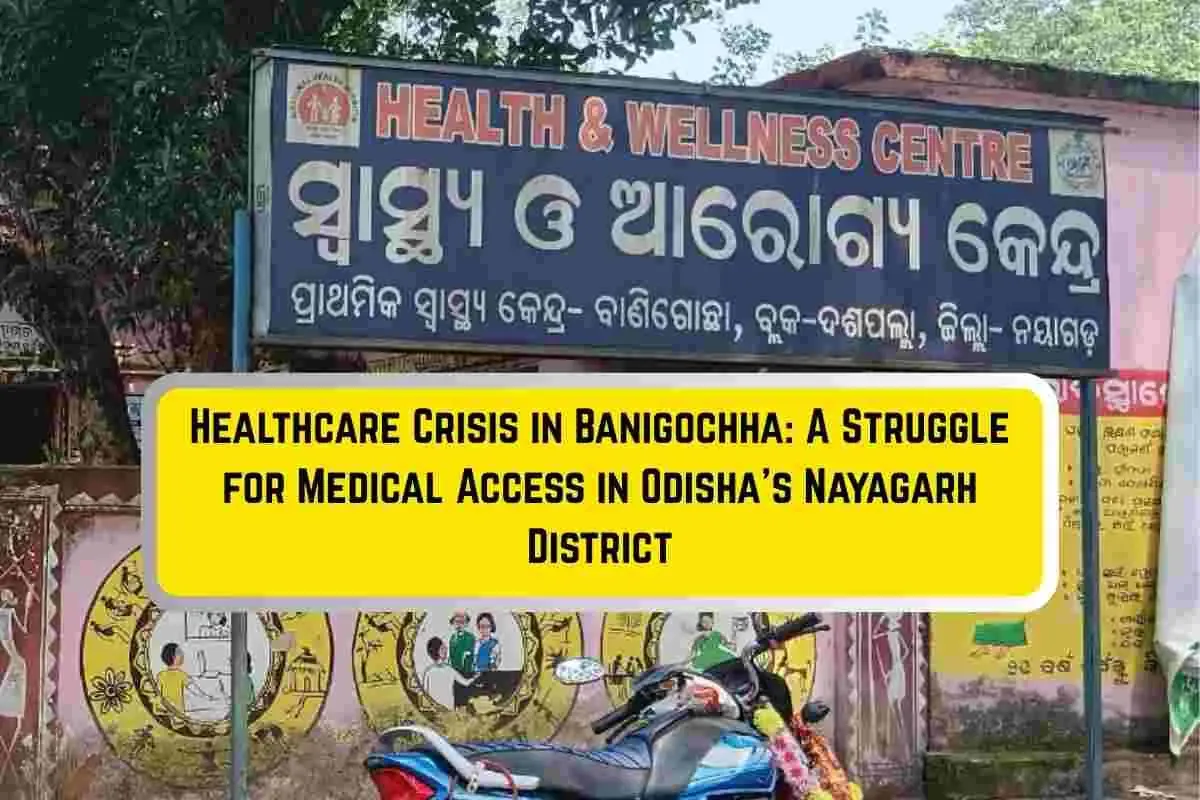Daspalla: (Report- Subas Chandra Barik): In the heart of western Odisha, the Banigochha Primary Health Center (PHC) in Daspalla block has long been a lifeline for thousands across Nayagarh, Boud, and Phulbani districts. However, this critical healthcare hub is now mired in a severe crisis due to the absence of doctors, leaving patients in distress and raising urgent questions about administrative negligence. The situation underscores a broader collapse of rural healthcare infrastructure in the region, disproportionately affecting marginalized communities and amplifying systemic failures.
Local residents report harrowing experiences. “My daughter had a high fever, but there was no doctor to examine her. The staff gave her pills, but her condition worsened,” said a distressed mother from a nearby village. Such stories are common, as patients are left with no choice but to rely on untrained personnel or embark on costly journeys to distant hospitals.
Even routine emergencies, such as accidents on National Highway 57—a notorious stretch for crashes—are met with inadequate responses. Accident victims are often rushed to ill-equipped CHCs, where the lack of doctors and infrastructure leads to delayed or substandard care. “We lost a young man last week because there was no surgeon to stop his internal bleeding,” shared a local ASHA worker.
The administration’s silence has fueled frustration. Health activists allege that vacancies remain unfilled due to bureaucratic delays and the state’s failure to attract doctors to rural postings. “The government talks about healthcare for all, but how will that happen without doctors?” asked a member of a local health NGO.
During monsoon seasons, the crisis deepens. Floods cut off remote villages, making PHCs inaccessible. “We’re left to treat malaria and snakebites with whatever supplies we have,” said a village health worker, a tribal hamlet.
The administration must act swiftly—not just to post doctors but to reimagine healthcare as a right, not a privilege. Until then, villages like Banigochha will remain symbols of a broken promise, where the right to health is overshadowed by systemic neglect.
A Hospital Without Doctors
Banigochha PHC, once a bustling center for primary healthcare, now stands eerily quiet, not due to a lack of patients but because of the glaring absence of medical professionals. Until recently, the facility was managed by two doctors: Dr. Biswajit Nayak and Dr. Kaliprasad Sadangi. However, both were abruptly transferred to Daspalla CHC, leaving Banigochha without a single qualified physician. This decision has forced lower-grade staff, such as fourth-class employees with no formal medical training, to step into roles far beyond their capacity. These workers now diagnose illnesses, prescribe medicines, and handle emergencies—a dangerous practice that jeopardizes patient safety and violates medical ethics.Local residents report harrowing experiences. “My daughter had a high fever, but there was no doctor to examine her. The staff gave her pills, but her condition worsened,” said a distressed mother from a nearby village. Such stories are common, as patients are left with no choice but to rely on untrained personnel or embark on costly journeys to distant hospitals.
A Systemic Failure Across Nayagarh
The crisis in Banigochha is not an isolated incident. Across Nayagarh district, community health centers (CHCs) and primary health centers (PHCs) are grappling with acute doctor shortages. Many facilities operate with just one doctor or, in some cases, only a pharmacist. This deficit hits hardest in tribal-dominated areas, where poverty and geographic isolation already limit access to care. During the COVID-19 pandemic, the cracks in the system widened. With local centers unable to provide basic services, patients flooded Nayagarh District Hospital, overwhelming its resources and forcing families to incur steep travel and treatment costs.Even routine emergencies, such as accidents on National Highway 57—a notorious stretch for crashes—are met with inadequate responses. Accident victims are often rushed to ill-equipped CHCs, where the lack of doctors and infrastructure leads to delayed or substandard care. “We lost a young man last week because there was no surgeon to stop his internal bleeding,” shared a local ASHA worker.
Administrative Apathy Amid Public Outcry
Despite repeated media coverage and public protests, the district administration has done little to address the vacancies. The transfer of Banigochha’s doctors to Daspalla CHC, which already had a functional team, has sparked accusations of mismanagement. Locals argue that the move prioritised political convenience over community needs. “Why strip one hospital to staff another? Both areas deserve adequate care,” demanded near by villagers.The administration’s silence has fueled frustration. Health activists allege that vacancies remain unfilled due to bureaucratic delays and the state’s failure to attract doctors to rural postings. “The government talks about healthcare for all, but how will that happen without doctors?” asked a member of a local health NGO.
The Human Cost of Neglect
The consequences of this neglect are dire. Maternal and child health services have deteriorated, with pregnant women traveling over 50 kilometers for deliveries. Chronic diseases like diabetes and hypertension go unmanaged, leading to preventable complications. Mental health support is virtually nonexistent. In tribal villages, where malnutrition and infectious diseases are rampant, the absence of mobile health units or consistent care has left communities vulnerable.During monsoon seasons, the crisis deepens. Floods cut off remote villages, making PHCs inaccessible. “We’re left to treat malaria and snakebites with whatever supplies we have,” said a village health worker, a tribal hamlet.
A Call to Prioritise Healthcare
The plight of Banigochha CHC reflects a national crisis in rural healthcare, where underfunding and apathy perpetuate cycles of suffering. For Odisha, a state lauded for disaster management but critiqued for healthcare access, resolving this issue is both a moral and practical imperative. As the state’s tribal and rural populations grow, so does the urgency to rebuild trust in public health systems.The administration must act swiftly—not just to post doctors but to reimagine healthcare as a right, not a privilege. Until then, villages like Banigochha will remain symbols of a broken promise, where the right to health is overshadowed by systemic neglect.






0 Comments